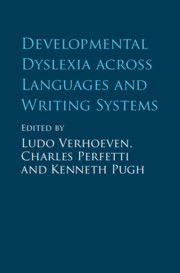Book contents
- Developmental Dyslexia across Languages and Writing Systems
- Developmental Dyslexia across Languages and Writing Systems
- Copyright page
- Contents
- Figures
- Tables
- Contributors
- 1 Introduction
- Part I Developmental Dyslexia across Languages and Writing Systems
- Part II Cross-Linguistic Perspectives on Developmental Dyslexia
- 11 Behavioral Precursors of Developmental Dyslexia
- 12 Neural Predictors of Developmental Dyslexia
- 13 Neurocognitive Markers of Developmental Dyslexia
- 14 Role of Visual Attention in Developmental Dyslexia
- 15 Morphological and Semantic Processing in Developmental Dyslexia
- 16 Modeling the Variability of Developmental Dyslexia
- 17 Modeling Developmental Dyslexia across Languages and Writing Systems
- 18 Etiology of Developmental Dyslexia
- 19 Intergenerational Transmission in Developmental Dyslexia
- Epilogue
- Index
- References
18 - Etiology of Developmental Dyslexia
from Part II - Cross-Linguistic Perspectives on Developmental Dyslexia
Published online by Cambridge University Press: 27 September 2019
- Developmental Dyslexia across Languages and Writing Systems
- Developmental Dyslexia across Languages and Writing Systems
- Copyright page
- Contents
- Figures
- Tables
- Contributors
- 1 Introduction
- Part I Developmental Dyslexia across Languages and Writing Systems
- Part II Cross-Linguistic Perspectives on Developmental Dyslexia
- 11 Behavioral Precursors of Developmental Dyslexia
- 12 Neural Predictors of Developmental Dyslexia
- 13 Neurocognitive Markers of Developmental Dyslexia
- 14 Role of Visual Attention in Developmental Dyslexia
- 15 Morphological and Semantic Processing in Developmental Dyslexia
- 16 Modeling the Variability of Developmental Dyslexia
- 17 Modeling Developmental Dyslexia across Languages and Writing Systems
- 18 Etiology of Developmental Dyslexia
- 19 Intergenerational Transmission in Developmental Dyslexia
- Epilogue
- Index
- References
Summary
Identical and fraternal twin pairs reared together have been key to understanding the genetic and environmental etiology of dyslexia and of individual differences in reading. In this chapter, we begin with a brief overview of the methods of twin research, and the historical development and application of these methods to understanding the etiology of individual differences and deficits in reading and related skills. Then we examine results from predominantly English-language twin research on dyslexia. The next section on twin studies of individual differences in reading ability introduces a broader cross-language perspective that includes comparisons of findings from studies in the United States, the United Kingdom, Australia, Norway, Sweden, the Netherlands, and China. Then we expand the reading phenotype beyond word recognition to reading comprehension, the ultimate goal of reading.
- Type
- Chapter
- Information
- Developmental Dyslexia across Languages and Writing Systems , pp. 391 - 412Publisher: Cambridge University PressPrint publication year: 2019
References
- 2
- Cited by

